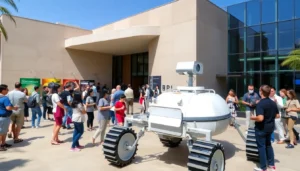Table of Contents
ToggleNavigating the cosmos might seem like a job for astronauts and rocket scientists, but thanks to the JPL map, even Earthlings can explore the universe from their living rooms. This interactive tool transforms the daunting task of space exploration into a fun and engaging experience. Whether you’re a curious novice or a seasoned space enthusiast, the JPL map invites everyone to discover the wonders of our solar system.
Overview of JPL Map
The JPL map serves as an innovative tool designed to enhance the exploration of space. Users easily navigate through a vast collection of celestial bodies, including planets and moons. Interactive features allow for engagement at various knowledge levels, making astronomy accessible to all.
Detailed graphics provide clarity on various astronomical phenomena. Each location on the map includes comprehensive information, including distance, composition, and historical significance. Users find educational resources integrated within the map, promoting deeper understanding.
Navigation options include zooming in on specific regions or accessing panoramic views of expansive areas. This versatility appeals to amateur astronomers and experienced researchers alike. With real-time updates, the JPL map reflects the most current discoveries in space exploration.
Tools for customization let users create personal journeys through the universe, combining different celestial objects. The intuitive interface draws users into learning experiences without overwhelming complexity. Community features enable sharing discoveries with other space enthusiasts, fostering collaboration.
Available on multiple platforms, including mobile devices and desktops, the JPL map encourages exploration anytime, anywhere. By providing a comprehensive resource, users gain insights into the universe’s wonders. This tool transforms how people engage with space, bridging gaps in knowledge and experience.
Features of JPL Map

JPL Map offers several features that enhance the exploration of celestial settings. These capabilities cater to users’ varying levels of knowledge in astronomy.
User Interface
The interface is designed for ease of use, allowing smooth navigation. Colors and iconography guide users effortlessly through the celestial landscape. Different menu options help access specific content quickly. Users find it intuitive, which improves the overall experience. Labels provide context for intricate details about celestial bodies. Accessibility is prioritized for all users, regardless of their expertise.
Interactive Capabilities
Interactivity is a hallmark of the JPL Map. Users can click on celestial bodies to reveal detailed information. Zoom functionalities allow for exploration at various levels, revealing expansive views and close-ups. Panoramic images provide a breathtaking perspective of astronomical features. Real-time updates ensure users stay informed about recent discoveries. Customization tools enable users to build personal exploration paths tailored to their interests. Community features invite collaboration, enhancing the social aspect of space exploration.
Applications of JPL Map
The JPL map serves diverse applications, significantly impacting scientific research and education.
Scientific Research
In scientific research, the JPL map acts as a vital resource. It provides astronomers and researchers access to a wealth of data about celestial bodies. Users explore the characteristics of various planets and moons, including their composition and historical context. Such detailed information supports ongoing studies and fosters innovation in space exploration. Additionally, real-time updates ensure researchers stay informed about the latest celestial discoveries. Collaborative features enable scientists to share findings, enhancing research outcomes through collective insights.
Educational Purposes
Educational purposes benefit immensely from the JPL map’s interactive design. Teachers utilize this tool to create engaging lessons centered on astronomy. Students gain firsthand experiences by exploring the universe in a visually stimulating manner. The map caters to different learning styles, making complex concepts accessible. With interactive features, learners can dive into specific regions of space, fostering curiosity and a deeper understanding. Community engagement enhances educational experiences, allowing students to collaborate and share discoveries with peers.
How to Access JPL Map
Accessing the JPL map is straightforward. Users can visit the official JPL website to find the interactive tool. A reliable internet connection enhances the experience, allowing seamless navigation through the celestial landscape.
Exploring the map requires minimal technical skills. The user-friendly interface guides individuals through various features with ease. Interactive elements facilitate clicking on celestial bodies for detailed information, making learning engaging.
Real-time updates reflect the latest discoveries in space exploration. Users receive notifications, ensuring they remain informed about new data. That keeps the exploration experience fresh and relevant.
Customization options further enhance accessibility. Users can create personal exploration paths tailored to their interests. Specific tools allow adjustments to views, facilitating how users interact with the map.
Mobile access expands opportunities for exploration. The JPL map is compatible with various devices, including smartphones and tablets. This compatibility means users can engage with the map on the go, whether in a classroom or at home.
Community features foster collaboration among enthusiasts. Users can share discoveries and insights with others, enriching the exploration experience. Such interactions create a sense of belonging within the space exploration community.
Classroom educators find the JPL map particularly beneficial. Teachers leverage the tool to deliver interactive lessons that captivate students’ attention. Students gain hands-on experience with astronomy, promoting curiosity about the universe.
Overall, accessing the JPL map invites individuals of all experience levels to explore the wonders of space. Active participation through its features offers a meaningful way to learn and discover.
The JPL map stands as a groundbreaking tool that democratizes space exploration. By merging user-friendly design with rich interactive features, it opens the cosmos to everyone. Whether someone is a novice or a seasoned astronomer, the map provides a unique platform for discovery and learning.
Its real-time updates and extensive data cater to researchers while also enriching educational experiences for students. This blend of accessibility and depth truly transforms how individuals engage with the universe. With the JPL map, exploring the wonders of space has never been easier or more enjoyable.







